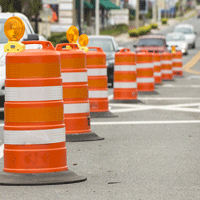Life-Saving Work Zone Safety Tips
June 19, 2018 In addition to family vacations, barbeques, and pool parties, summer is roadwork season. From busy interstate highways to local roads and residential streets, a wide range of construction projects are completed this time of year because of the mild temperatures. However, the increased number of work zones combined with heavier summer traffic can lead to serious car accidents and fatalities involving road construction workers. Within a year, 136 construction workers lose their lives in car accidents, according to the Bureau of Labor Statistics. Many of these tragic accidents can be avoided by keeping the following important safety tips in mind.
In addition to family vacations, barbeques, and pool parties, summer is roadwork season. From busy interstate highways to local roads and residential streets, a wide range of construction projects are completed this time of year because of the mild temperatures. However, the increased number of work zones combined with heavier summer traffic can lead to serious car accidents and fatalities involving road construction workers. Within a year, 136 construction workers lose their lives in car accidents, according to the Bureau of Labor Statistics. Many of these tragic accidents can be avoided by keeping the following important safety tips in mind.
- Follow a transportation management plan. This should include a traffic control plan that directs traffic safely around and through the work zone. In addition, there should be a plan that controls the flow of heavy equipment, construction vehicles, and workers within the work zone.
- Control traffic. Motorists should be alerted in advance that they are approaching a work zone and that there will be changes in driving conditions, including merging lanes and shifts in traffic patterns. Traffic control devices like cones, barrels, and signs should be used for lane closures and to protect the work area.
- Create separate work areas. Cones, barrels, and other barriers should be used to create specific areas within the work zone, including material storage, heavy equipment areas, vehicle parking, and safe spaces for workers.
- Always wear appropriate safety equipment. Hard hats, steel-toed boots, highly visible clothing, and hearing and eye protection should be worn when necessary. The equipment should meet the standards developed by the American National Standards Institute.
- Stay alert. Work zones are busy, hectic places, so it is important to be aware of your surroundings. Avoid walking behind or near large vehicles or heavy equipment. Face traffic whenever possible so that you can avoid being hit by a passing car.
- Avoid blind spots. If you cannot see the driver who is operating a piece of equipment, assume that they cannot see you.
- Assign a competent person to oversee the work site. According to the Occupational Safety and Health Administration, this person should be capable of identifying hazards, including unsanitary or unsafe work conditions. They should have the authority to take immediate measures to correct or eliminate the problem.
- Conduct daily safety meetings. At the beginning of each day, meet with the crew and go over the potential hazards, as well as recommended action steps to control them. If inclement weather causes slippery road conditions or affects visibility, make sure that motorists are warned that they are approaching a work zone and to use caution.
- Stay hydrated. It can get extremely hot working outside, especially when there is no shade. Drink plenty of water and other drinks that are high in electrolytes, like sports drinks or coconut water. Take regular breaks to get out of the direct sun. Dehydration, heat exhaustion, and heat stroke can be very serious if a worker does not receive medical attention.
Baltimore Car Accident Lawyers at LeViness, Tolzman & Hamilton Represent Victims of Work Zone Accidents
If you have been injured in a car accident that took place in or near a work zone, contact the Baltimore car accident lawyers at LeViness, Tolzman & Hamilton at your earliest convenience. We will investigate the details of the accident and secure the maximum financial compensation that you deserve. Protecting your rights is our top priority and we will not stop fighting for you until justice has been served. To schedule a free consultation, call us today at 800-547-4LAW (4529) or contact us online.
Our offices are located in Baltimore, Columbia, Glen Burnie, and Towson, allowing us to represent car accident victims in Maryland, including those in Anne Arundel County, Baltimore County, Carroll County, Harford County, Howard County, Montgomery County, Maryland’s Western Counties, Prince George’s County, Queen Anne’s County, Southern Maryland, and the Eastern Shore, as well as the communities of Catonsville, Essex, Halethorpe, Middle River, Rosedale, Gwynn Oak, Brooklandville, Dundalk, Pikesville, Nottingham, Windsor Mill, Lutherville, Timonium, Sparrows Point, Ridgewood, and Elkridge.






